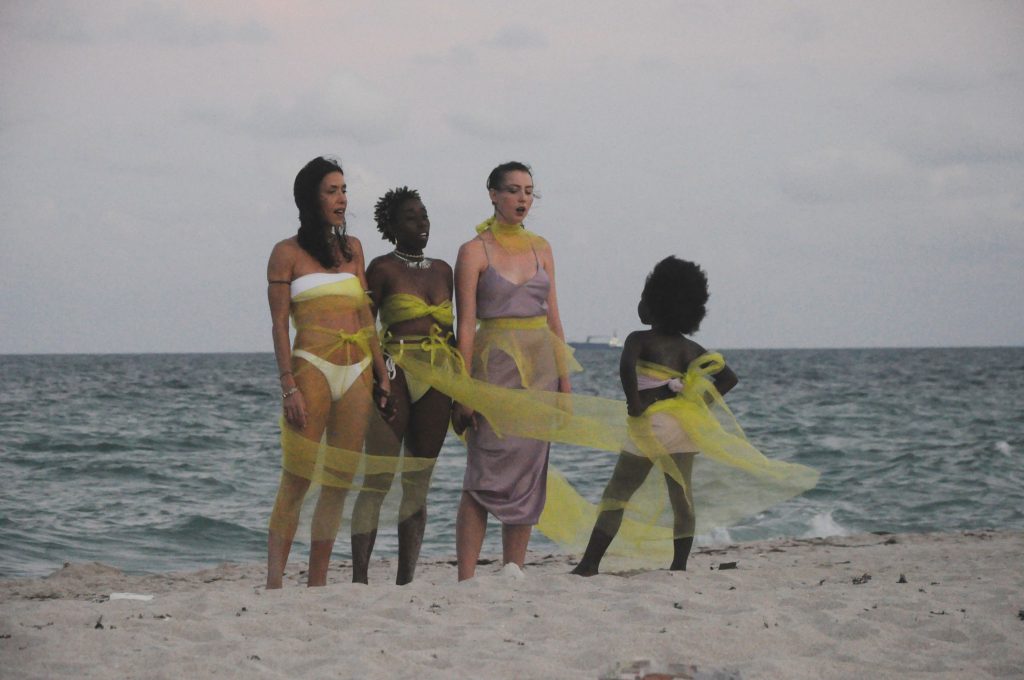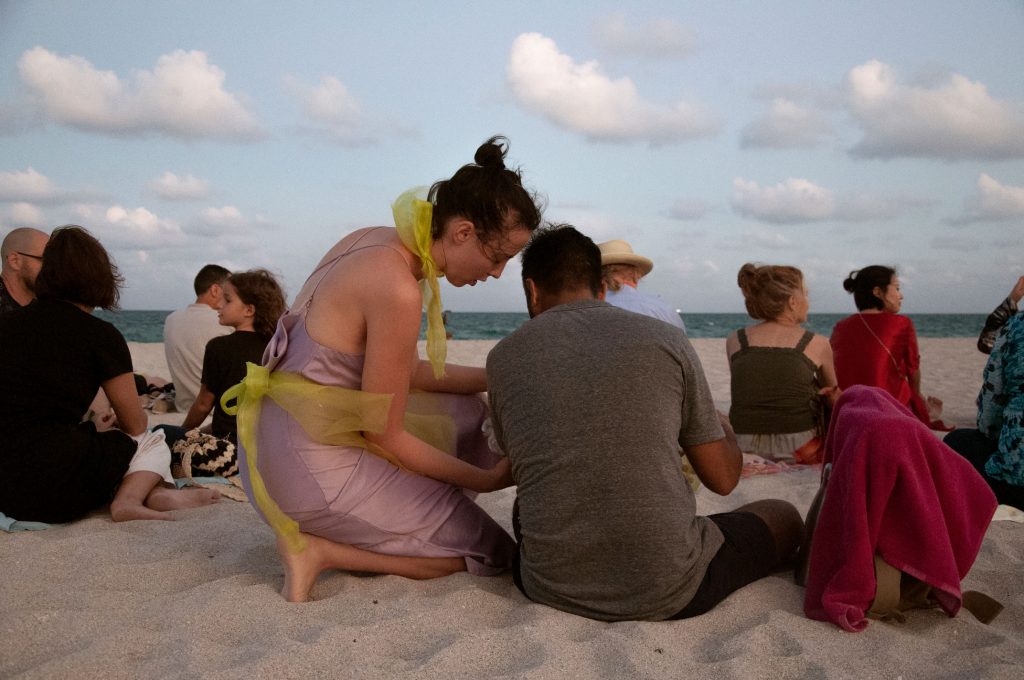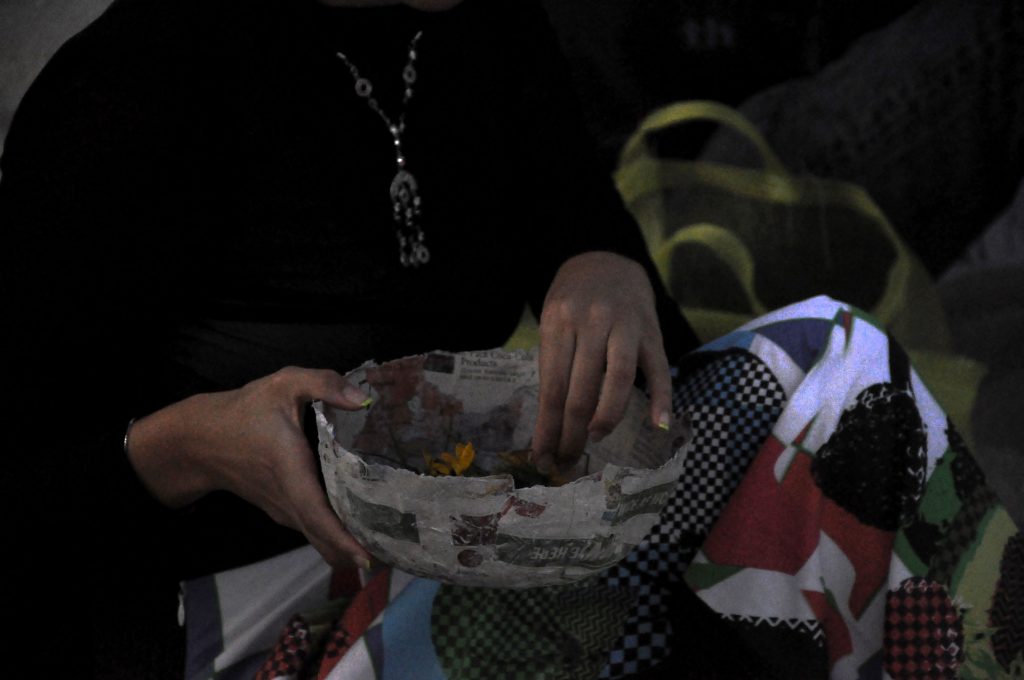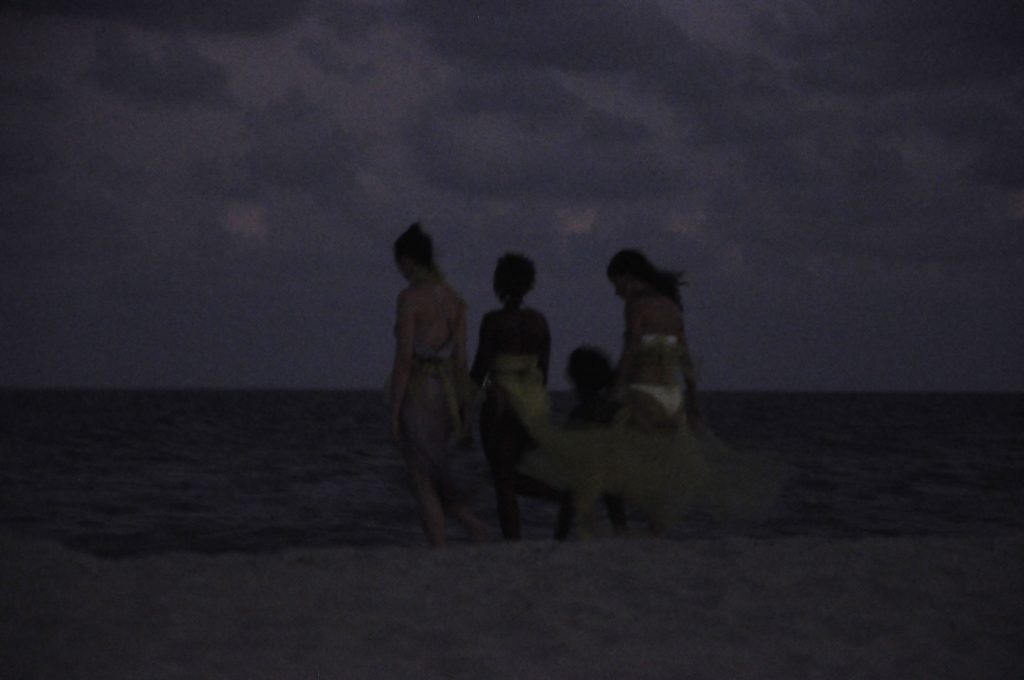Three human figures are swaying softly in the distance. Elbow to elbow, they’re rocking and singing in unison as a small child is stood (hands on her hips, but fidgety) in front of them. The adults have their backs to the Atlantic Ocean, facing the Miami Beach sunset over the city. They’re not wearing much apart from one form of underclothes or another, loosely wrapped in swathes of a diaphanous golden fabric. It’s exactly 7:11pm on Saturday September 29 and there’s a cluster of participant onlookers sitting cross-legged, barefoot and on towels in a loose semi-circle demarcated by a vague line drawn in the sand of the half human-made coastal barrier.

The flyer for Hayden Dunham’s ‘IN: the serpent :TO’ (pronounced “into the serpent”) collaborative dusk performance describes it as an “interactive exhibition” and comes with detailed instructions on where to meet—by the lifeguard tower on the beach. Organisers Naomi Fisher and Lee Pivnik of BFI Miami stress the importance of being on time (the sunset waits for nobody) at the Collins Park Rotunda a few days before. There, New York and LA-based artist Dunham is joined by Miami-based collaborator Katerina Llanes’ for this ‘Hydra’s Rain’ talk about their ecologically-focused series, named after a regenerative, self-healing plant that doesn’t age.
Inside the sand cast bas-relief of the original Miami Beach Public Library, audience and presenters sit in an egalitarian circle at a grand round table spanning the cylindrical auditorium, temporarily rebranded The Department of Reflection by Misael Soto. The artist and founder of the parafictional municipal body briefly introduces their project, as does Katherine Fleming, who applies her background in fashion and PR to a billboard campaign promoting awareness around a looming climate change catastrophe through her Bridge Initiative. These projects are well-placed alongside Dunham and Llanes’ work except for the latter’s considerably more composite sensibility and approach to, as Fisher describes it, their “magical, spiritual, environmental” methodology.
The sound component of ‘Hydra’s Rain’, produced in collaboration with umru, has been installed at the Bass Museum nearby. It’s a guided meditation perceivable only through Dunham’s disembodied whispers dispersed across the building’s two floors. An ethereal vocal, often indistinguishable from the rise and fall of an analogous synth line, echoes through a swell of atmospherics in the large indoor courtyard downstairs. Synth pads and human mumblings flower and fade in cycles through the hum of gallery chatter upstairs, where Dunham’s audio inhabits the monumental woven landscapes of Sheila Hicks’ Campo Abierto (Open Field) exhibition.

Back on the beach, local herbalist and ‘IN: the serpent :TO’ collaborator Albertte Petithomme is moving in a wave-like motion and singing on her own. The evening sea-breeze is buffeting her sustained vocal, obscuring its audibility from the listening, seated onlookers in the noise of moving air. The yellow mesh around her waist flaps along with it. Dunham and Llanes, move, crouch and walk in their own ambiguous choreography, while Petithomme’s young daughter, Nefertiti, worms around in the sand before them. The pink and pale blue hue of the sky behind them grows greyer.
The trajectory of IN: the serpent :TO (Hydra’s Rain) stretches as far as 2013. Driving across country from New York to Miami, with a detour through the American Southwest, Llanes began a dialogue with Dunham who was developing a body of work called ‘Transparent Uploads’. Together they hit a number of energetic hot spots—the chakras of the earth—in Nevada, New Mexico, Texas. The two of them embodied different elements and documented their interactions along the way. During the ‘Hydra’s Rain’ conversation in Miami, Llanes describes the beginnings of the undertaking as “a seed that was planted a long time ago”, journeying along these original “listening stations” only to blossom into a project by Dunham spanning years and global locations in New York, Sydney, Cornwall. “I deeply believe that you plant seeds with not necessarily a conscious knowing of what fruit you’re going to get later,” Llanes says about the role of serendipity in the work, and the universe more generally, “but there are links everywhere, all the time, and paying attention to that synchronicity puts you in a place of alignment.”

Before the Miami Beach performance begins, BFI organisers give out cards—hand drawn and splashed with watercolour—along with small, lightly sewn pouches made of the same yellow garden netting worn by the ‘IN: the serpent :TO’ performers. A folded zine opens out into fragments of a poem, and an itemized list of locally foraged plants, seeds and minerals, along with descriptions of their therapeutic properties. Petithomme, Llanes and Dunham each represent a classical element of earth, water, wind, along with fire in the form of Nefertiti’s serpent life force, as they busy themselves within the assigned roles of their opaque ritual, while the audience looks on.
“We’ve really focused on plants specific to Miami and South Florida that are used for supporting lymphatic systems,” says Dunham at the Collins Park Rotunda. “[We’re] thinking about the human body, and water within the human body as being a parallel for the ocean, and what the ocean is really having to do right now with the environments that we have made for it.” Initially inspired by the so-called red tide common to the Gulf of Mexico, IN: the serpent :TO (Hydra’s Rain) series ultimately explores the implied relationship between humans caring for their bodies and caring for the ocean. Algal blooms are triggered by a number of factors. It’s unclear what combination of wind, salinity, nutrients and temperature is its cause and how much people have to do with it, but there are clear correlations between an increase in these toxic environmental events and global warming. The human lymphatic system can also become dysregulated for similarly hypothetical reasons, turning on the body and causing autoimmune disease. The body becomes a microcosm of what’s happening to the planet.

“Take what you need and pass it out”, says Nefertiti, at the instruction of Dunham, while handing over another papier-mâché bowl holding a tangle of Spanish moss. It’s a subtropical plant that grows on the surface of trees and subsists off the air, rain, water and debris of its environment. When made into a tea it can relieve contraction pain and fever, and right now it accompanies the quartz, limestone, Moringa seeds, sea grapes circulating amongst the ‘IN: the serpent :TO’ audience. An accompanying ‘Hydra’s Rain’ flyer advises on what to do with the containers and their contents: “use you hands to listen for the ones you need… be thoughtful in your choices.” There are planes flying overheard, the hum of their engines merging with the crash of the waves in the distance. Two passersby and their dog are standing and watching the action in the shadows. It’s almost dark. Dunham and Nefertiti bury the last of the organic bowls and rejoin Llanes and Petithomme to walk away and disappear into the ocean horizon. Sinking into the water, they return to where they came from.**













